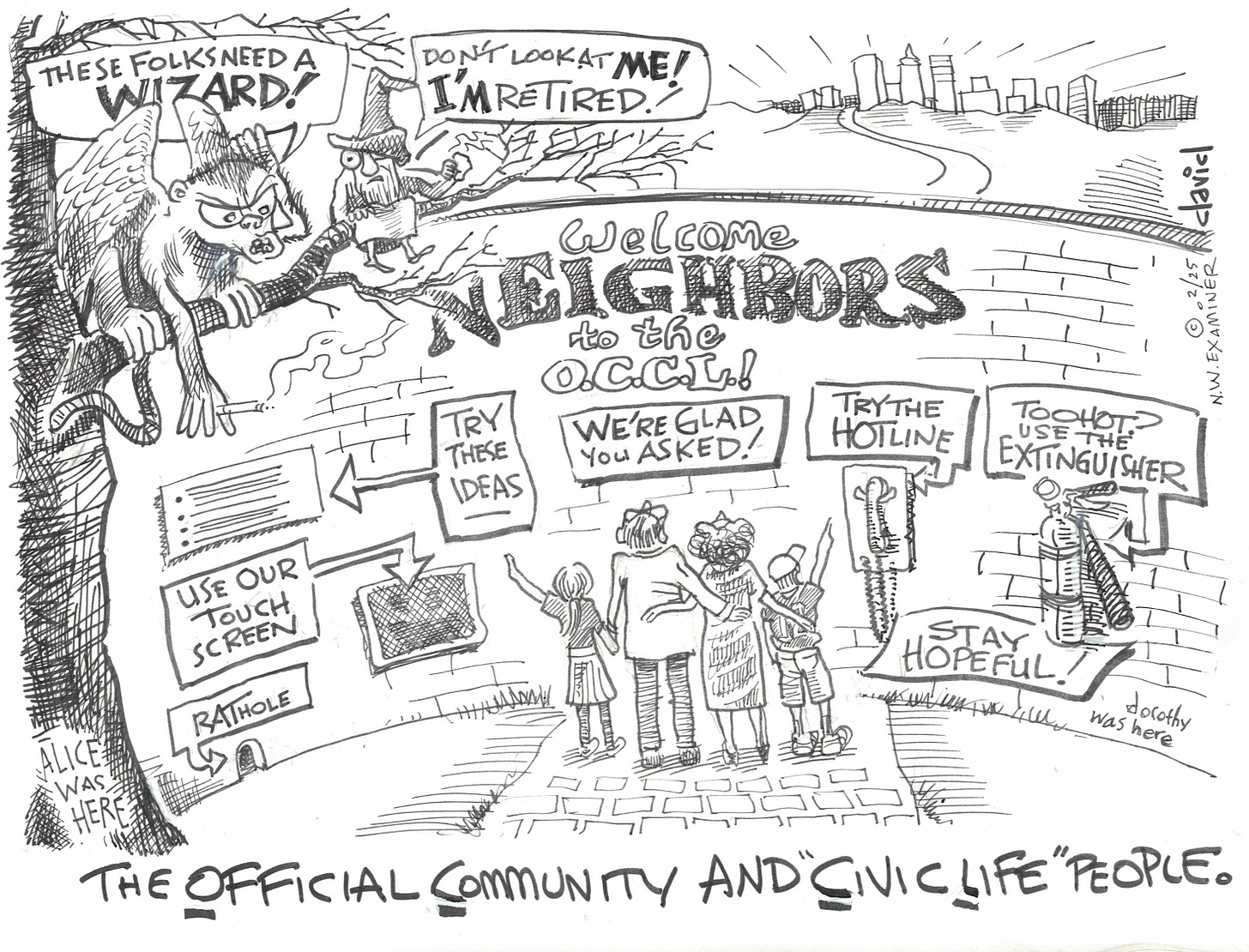Lost on the yellow brick road
Our recently installed city officials are getting plenty of advice on the top issues facing Portland, but I have some observations on what’s going on at the lower end. That’s where the Portland renaissance took root during the Goldschmidt Era, as residents were encouraged to remain in the city by giving them a voice in shaping their neighborhoods, schools and the downtown. The city’s pioneering neighborhood program, providing funds and channels for participation, became a model touted across the country.
That program still exists, though it has been renamed to reflect the diminished role of neighborhood associations. The original structure of independent neighborhood coalitions across the city has also been diluted by charter reform, reduced to just four large districts that don’t reflect any particular character or interests.
The four new coalition offices are swamped with expectations to provide at least skeletal services to large conglomerations of neighborhoods having no common history. Never mind coming together on public policy goals; just connecting each to internet service, online meeting technology, liability insurance and tax filing support is blowing gaskets.
Meanwhile, some of the most effective citizen advocacy is happening outside the system. Friends of Couch Park and the Stadiumhood organization are making news and getting results in the often-forgotten southeast corner of the Northwest District. Friends of Wallace Park has been functioning for six years, sponsoring communitywide celebrations and volunteer cleanup events in the manner typically carried out by neighborhood associations.
These independent groups formed by neighbors to address pressing issues perceive no benefit in joining what was once the mightiest Portland neighborhood association of them all, the Northwest District Association.
Neighborhood activists across the city increasingly go directly to the City Council with their biggest concerns, teaming up to make pointed presentations in the three-minute public comment slots at the beginning of each council session. They typically bring a handful of speakers, who in turn lay out complex situations. On occasions, this direct approach has sparked intense interest from and follow-up from council members. The same process is now being employed frequently at the Multnomah County Council, which has jurisdiction over an expanding range of livability issues.
The direct approach is preferred by citizens serious about making change because the filters and layers of official participation dampen rather than enhance their best approaches. Staff at the Office of Community and Civic Life have been hostile to areas of the city deemed privileged, and aides to council members have generally been no better. Official citizen advisory bodies, such as the Northwest Parking Stakeholders Advisory Committee, bring a cadre of city officials to get buy-in on city expenditures rather than modifying their assumptions based on local feedback.
Those going through the official channels have found that getting a sit-down meeting with a council member has been harder than reaching the Wizard of Oz.
The new system is supposed to get beyond all the obfuscation because each district now has three representatives on council. We can expect some improvement, but such access would only make OCCL more irrelevant, which in the end will—like any institution—cause it to resist with all of its resources. The same may hold for the district coalitions, which at first blush appear to be more interested in forming their own internal committees than creating a better path to the people holding power.
A better neighborhood system would not need more funding; in fact, it would probably need far less. Everything in the way of good citizens getting together and sharing their best ideas is a detriment, and vital grass-roots organizations can cover their necessities from donations and membership dues, just as the groups mentioned above have done.
Some have suggested that there will be no need for district coalition offices or even neighborhood associations because council members in each district will be more approachable. They may have stumbled upon something, but for the wrong reason. Citizens and neighborhoods will always need to come together and find their voice. We have to ask if the system Portland has created advances that goal or rather has just kept people busy chasing their tails.
Above all, we need to appreciate the difference between public goals and the means of accomplishing them. Agencies are created to serve social missions. Over time, they tend to preserve the agencies and lose track of the mission.



